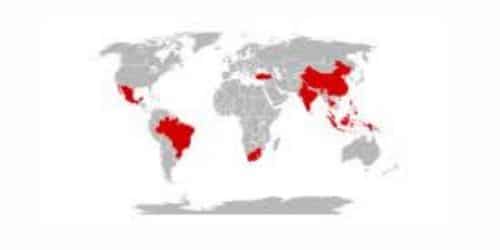Generally, investors and businesses are perpetually in search of novel opportunities for expansion and diversification. With the maturation and saturation of traditional markets, there is a growing focus on a dynamic group of economies referred to as “Emerging Markets.” These are economies that are distinguished by their swift industrialization, burgeoning middle class, and considerable growth prospects. Over the years, these economies have garnered the interest of astute investors seeking to leverage untapped opportunities although filled with a lot of risks. What are emerging markets all about and how can you identify them? Let’s find out!
What Is Emerging Markets?
An emerging market refers to a country or a group of countries in the process of rapid industrialization, economic growth, and increasing their participation in the global economy. In simpler terms, it shows signs of development but doesn’t yet satisfy the standards of a developed market. This includes both currently developing markets and those that may develop in the future. These markets are typically characterized by lower income levels compared to developed countries but exhibit high growth potential and a transition toward more advanced economic structures.
Understanding Emerging Markets
Emerging markets are countries experiencing rapid economic growth and transitioning from low-income agrarian economies to more advanced structures. They often have large and young populations, attracting foreign investments and offering substantial consumer markets. While they present investment opportunities, they also come with risks, such as political instability and currency fluctuations. Understanding regional differences, cultural factors, and their impact on the global economy is essential for businesses and investors to navigate these dynamic economies successfully.
Characteristics of Emerging Markets
Identifying emerging markets involves analyzing various economic and financial indicators to assess a country’s growth potential and its readiness for increased participation in the global economy. While there is no one-size-fits-all approach, here are some common methods and indicators used to identify emerging economies:
#1. Industrialization and Economic Structure
Examine the country’s economic structure and its shift from agriculture-based to more industrial and service-oriented sectors. An economy that is transitioning towards more advanced industries can be a sign of emerging economy potential.
#2. Economic Growth and GDP Growth Rate
Another key characteristic of an emerging economy is its economic and GDP growth rate. Look for countries that have sustained high economic growth rates over the past few years. A consistently increasing Gross Domestic Product (GDP) indicates a growing economy.
#3. Population and Demographics
Consider the country’s population size and demographic trends. A young and growing population often indicates a potential demographic dividend, where a large portion of the population enters the workforce, supporting economic growth. Therefore, it’s one of the key characteristics of an emerging economy.
#4. Infrastructure Development
Evaluate the level of infrastructure development in the country. Improving transportation networks, communication systems, as well as energy facilities are signs of a growing economy.
#5. Foreign Direct Investment (FDI) Inflows
Observe the amount of foreign direct investment flowing into the country. Significant FDI indicates foreign investors’ confidence in the country’s economic prospects. Therefore, it’s also one of the key characteristics of an emerging economy.
#6. Trade and Export Trends
Analyze the country’s trade relationships and export trends. A rise in exports indicates competitiveness in the global market.
#7. Political Stability and Governance
Assess the country’s political stability and the effectiveness of its governance structures. A stable political environment is crucial for sustainable economic growth.
#8. Market Size and Consumer Base
Consider the size of the country’s domestic market and its potential as a consumer base for goods and services. A large consumer base can attract businesses and investors.
#9. Financial Market Development
Examine the development of the country’s financial markets, including the stock exchange, banking sector, as well as the availability of financial instruments.
#10. Global Competitiveness and Business Environment
Evaluate the country’s competitiveness in global markets as well as the ease of doing business. A favorable business environment can attract international investments.
#11. Human Capital and Education
Consider the quality of the country’s education system as well as the level of human capital development. Skilled and educated workers can contribute to economic growth and innovation.
#12. World Bank and IMF Classifications
Check the classification of the country by international organizations like the World Bank or the International Monetary Fund (IMF). They often categorize countries based on income levels and economic development stages.
What Are the Top 5 Emerging Markets?
As of the time of this write-up, the top 5 emerging economies are
- China
- Indonesia
- Vietnam
- India
- Georgia
How Do You Identify Emerging Markets?
Emerging markets are identified in the following ways; income levels, financial stability, and economic expansion rates are all interrelated. However, the most common means of identifying an emerging economy is the country’s GDP. It mostly has at least 3% GDP and low to mid-range per capita income. This indicates that the country is industrializing but that the average income is still quite low, prompting its citizens to strive for better living conditions.
What Is an Example of an Emerging Market?
India, Mexico, Russia, Pakistan, Saudi Arabia, China, and Brazil are all good examples of emerging economies.
What Are the 7 Largest Emerging Markets?
The 7 largest emerging economies are:
- Brazil
- China
- India
- Indonesia
- Mexico
- Russia
- Turkey
Can Money Be Made Investing in New Markets?
Due to their potential for faster GDP growth than more established economies, investments there tend to pay off well. However, investing in these markets is not without its dangers, including but not limited to political unpredictability, a dearth of trustworthy information, currency changes, reduced liquidity, and investment volatility. Before making any investment, you should think long and hard about the pros and cons.
What Makes an Economy an Emerging Market Economy?
There is no universally agreed-upon way to categorize emerging economies. The precise list of emerging market economies might vary depending on who you ask about income levels, financial system quality, and growth rates. The International Monetary Fund (IMF) and Morgan Stanley Capital International (MSCI) each place different numbers of countries in their emerging markets categories. The two listings don’t quite match up with one another. Different rating agencies have different definitions for what constitutes an emerging market economy; S&P lists 23 nations, FTSE Russell lists 19, and Dow Jones lists 22. A country can be removed from the list if it is either deemed a developed nation or demoted to the category of “frontier nation” by one of these organizations.
Emerging Markets ETF Vanguard
Vanguard offers several Exchange-Traded Funds (ETFs) related to emerging markets. These ETFs aim to provide investors with exposure to the equity markets of emerging market countries, which are regions experiencing rapid industrialization as well as economic growth. The VWO FTSE Emerging Markets ETF is a good example of emerging markets ETF offered by Vanguard.
The Vanguard FTSE Emerging Markets ETF (VWO) is one of the prominent exchange-traded funds (ETFs) offered by Vanguard. It provides investors with exposure to the equity markets of emerging markets countries, which are regions experiencing rapid economic growth and industrialization.
Emerging Markets ETF Vanguard: Objective
The primary objective of the Vanguard FTSE Emerging Markets ETF (VWO) is to track the performance of the FTSE Emerging Markets All Cap China A Inclusion Index. This index represents the overall equity market performance of emerging market countries and includes companies of various market capitalizations, including large, mid, small, and micro-cap stocks. The “China A Inclusion” aspect refers to the inclusion of China’s A-shares in the index, making it more comprehensive in covering the Chinese equity market.
Emerging Markets ETF Vanguard: Holdings
As an index-tracking ETF, VWO holds a diversified portfolio of stocks from companies based in various emerging market economies worldwide. The specific countries and companies represented in the ETF’s holdings will align with the constituents of the FTSE Emerging Markets All Cap China A Inclusion Index.
Emerging Markets ETF Vanguard: Diversification
VWO provides investors with broad diversification across numerous emerging economy companies and industries. This diversification aims to reduce the impact of individual stock performance on the overall investment. Diversifying across multiple countries and industries can help spread risk in the portfolio.
Emerging Markets ETF Vanguard: Expense Ratio
Vanguard is well-known for its commitment to low-cost investing, and VWO follows this approach. The expense ratio for VWO is typically low compared to many other investment options. The expense ratio represents the fee charged to investors and can impact overall returns over time.
Emerging Markets ETF Vanguard: Risks
Investing in emerging economies carries inherent risks, including higher volatility, political and regulatory uncertainties, currency fluctuations, and potential liquidity issues. The performance of VWO will be influenced by the economic conditions and market developments in the countries represented in the index.
ETF For Emerging Markets
According to Vanguard Group, emerging markets ETFs generally combine investments in countries that are considered to have “developing” economies. These include countries like India, Brazil, and China. An Exchange-Traded Fund (ETF) for Emerging Markets is a type of investment fund that tracks and aims to replicate the performance of an index representing the securities of companies in emerging market economies. These ETFs provide investors with exposure to the growth potential and economic opportunities of these developing countries.
Emerging markets are regions that have lower income levels and are in the process of rapid industrialization and economic growth. Some well-known emerging markets include countries from Asia, Latin America, Africa, the Middle East, and Eastern Europe.
ETFs for Emerging Markets typically invest in a diversified portfolio of stocks or other securities from companies based in these regions. The holdings within the ETF can vary depending on the underlying index it tracks, and they may cover a wide range of industries and sectors.
As with any investment, it’s important to carefully consider your risk tolerance, investment goals, and the specific characteristics of the ETF before making investment decisions. Additionally, past performance is not indicative of future results, so conducting thorough research and due diligence is crucial before investing in any financial product.
Benefits of Investing in Emerging Markets ETFs
The following are some of the benefits of investing in emerging markets ETFs:
#1. Diversification
By investing in an ETF, you gain exposure to a basket of securities from various companies across different industries and countries. This diversification can help spread risk and reduce the impact of individual company performance.
#2. Growth potential
Emerging markets have the potential for high economic growth rates compared to developed markets. As these economies grow, the companies within them may see increased profitability and stock value, potentially leading to higher returns for investors.
#3. Access to hard-to-reach markets
Investing in individual companies in some emerging economies can be challenging due to regulatory complexities and limited information. ETFs offer a more accessible and efficient way to invest in these markets.
#4. Lower expenses
ETFs often have lower expense ratios compared to actively managed mutual funds. This means you pay less in management fees, allowing more of your investment to compound over time.
Risks and Factors Associated with ETFs for Emerging Markets
The following are some of the factors or risks involved in ETFs for emerging economies:
#1. Higher volatility
Emerging markets can be more volatile than developed markets due to political instability, economic fluctuations, and currency risks. Sudden changes in government policies or economic conditions can lead to significant fluctuations in stock prices.
#2. Currency risk
Investing in companies that operate in emerging markets exposes investors to currency exchange rate fluctuations, which can impact overall returns.
#3. Political and regulatory risks
Emerging markets may have less developed legal and regulatory systems, making it riskier to invest in companies operating in these regions.
#4. Liquidity risk
Some ETFs for Emerging Markets may have lower trading volumes, leading to wider bid-ask spreads and potentially higher trading costs.
Is Africa an Emerging Market?
Yes, Africa is an emerging market. Several countries in Africa have been recognized as emerging economies. South Africa, Nigeria, and Egypt are some of the countries that international economies have recognized as emerging economies.
- The Role of Communication Skills in a Business Environment
- VANGUARD ETFS: Meaning & What You Should Know
- WHAT DOES THE FEDERAL RESERVE DO?
- Mergers and Acquisitions 2023: Differences and Examples
- Economy Recession: Definition, Causes, Effects & Solution.






